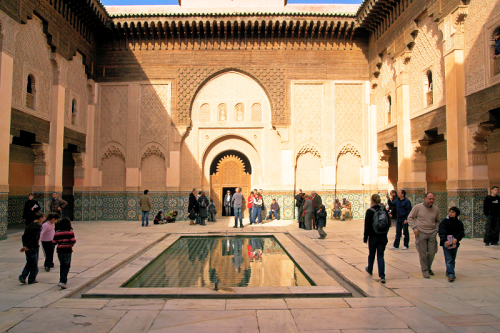Ben Youssef Madrasa
This is a gathering of Lovers.
In this gathering
there is no high, no low,
no smart, no ignorant,
no special assembly,
no grand discourse,
no proper schooling required.
There is no master,
no disciple.
In this gathering
there is no high, no low,
no smart, no ignorant,
no special assembly,
no grand discourse,
no proper schooling required.
There is no master,
no disciple.
Jalal al-Din Muhammad Rumi
The Ben Youssef Madrasa in Marrakech is one of the most beautiful places in this vibrant North African city. Within its walls you find tranquility and beauty unsurpassed by any other monuments here.
 |
| The central courtyard of the Madrasa |
The Ben Youssef Madrasa is named after the amoravid sultan Ali ibn Yusuf (reigned 1106–1142), who expanded the city and its influence considerably, but was founded much later during, in the 14th century by the Marinid sultan Abu al-Hassan.
 |
| View from one of the dormitories |
The building was re-constructed in the 16th century by the Saadian Sultan Abdallah al-Ghalib(1557–1574).
Closed down in 1960, the The Ben Youssef Madrasa building complex was refurbished and reopened to the public as an historical site in 1982.
Closed down in 1960, the The Ben Youssef Madrasa building complex was refurbished and reopened to the public as an historical site in 1982.
 |
| The beautiful court seen from the main entrance |
The Ben Youssef Madrasa was one of the largest theological colleges in North Africa and may have housed as many as 900 students.
One of its best known teachers was Mohammed al-Ifrani (1670-1745).
The beautiful main courtyard is partly built in cedar mable and stucco and it is extremely ornate.
The carvings covering the walls have no representation of humans or animals as required by Islam, and consist entirely of inscriptions and geometric patterns. In the middle you have a beautiful pool in cool blue and green mosaic tiles.
The 130 student dormitory cells at the Ben Youssef Madrasa face this court. It feels so strange being inside these tiny rooms where generations of pious young men have studied their holy book.
It is a surprise really to find a space like Ben Youssef Madrasa in a city as Marrakech. The refined beauty of its interior is a contrast to the rough and charming exterior of the streets outside. The space here is actually like many others found in Marrakech. You are suddenly removed to a beautiful quiet room far away from the commotion of the streets outside.
You are suddenly back to its grand era, when, as you are wander in the courtyard hear the call of the muezzin at the nearby Ben Youssef Mosque. I caught this on this short film clip taken during my visit.
One of its best known teachers was Mohammed al-Ifrani (1670-1745).
The beautiful main courtyard is partly built in cedar mable and stucco and it is extremely ornate.
The carvings covering the walls have no representation of humans or animals as required by Islam, and consist entirely of inscriptions and geometric patterns. In the middle you have a beautiful pool in cool blue and green mosaic tiles.
The 130 student dormitory cells at the Ben Youssef Madrasa face this court. It feels so strange being inside these tiny rooms where generations of pious young men have studied their holy book.
It is a surprise really to find a space like Ben Youssef Madrasa in a city as Marrakech. The refined beauty of its interior is a contrast to the rough and charming exterior of the streets outside. The space here is actually like many others found in Marrakech. You are suddenly removed to a beautiful quiet room far away from the commotion of the streets outside.
You are suddenly back to its grand era, when, as you are wander in the courtyard hear the call of the muezzin at the nearby Ben Youssef Mosque. I caught this on this short film clip taken during my visit.
morocco culture,moroccan food,morocco food,moroccan cuisine,morocco beaches,moroccan meal,beaches in morocco,moroccan culture,hercules cave,hercules cave morocco





